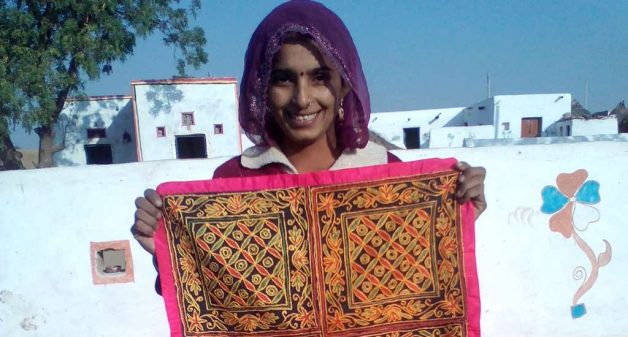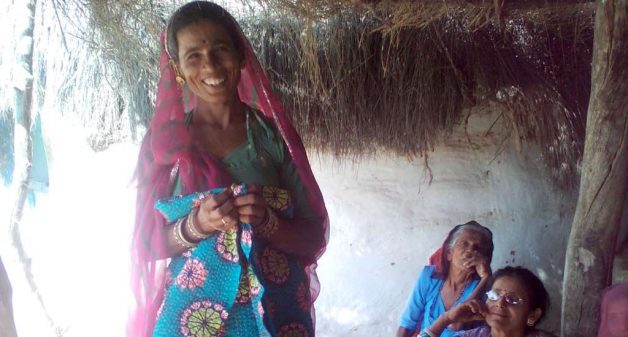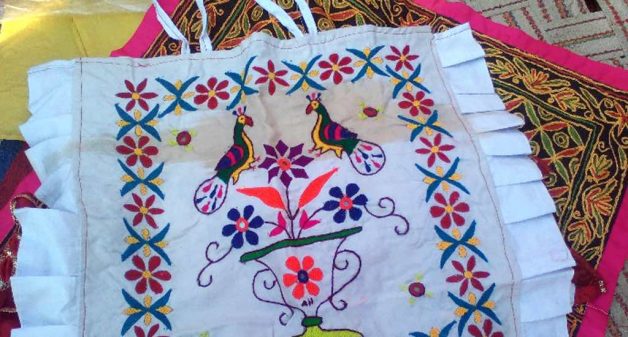
Kashidakari women look to grow embroidery earnings
Women in Jodhasar, who have begun embroidering for a living by putting traditional skills they used for embellishing personal clothing to good use, need better market linkages to boost incomes

Women in Jodhasar, who have begun embroidering for a living by putting traditional skills they used for embellishing personal clothing to good use, need better market linkages to boost incomes
Jodhasar, once a tiny settlement, has emerged as a craft village in the past few years. The village is located in Sri Dungargarh tehsil in Bikaner district of Rajasthan. The women embroidery workers in Jodhasar have their roots in Pakistan, having walked their way into India at the time of India-Pakistan War in 1971.
Their style of embroidery is called kashidakari in the local language. The women learn to do embroidery work very early, between the age of 10 and 12. In the late afternoons, they sit together making embroidery products, mainly for their own use, or to be given as wedding trousseau to their offspring.
In the late 1980s, a few non-governmental organizations (NGOs) started to reach out to these women artisans to provide livelihood opportunities. Soon retail shops, multi-brand retail outlets and a few private players started to place orders, encouraging their art and improving the livelihoods of the women. However, such initiatives have not been able to generate sustainable revenue for the artisans.
Meager income
“We cannot earn a decent living as women artisans. The orders are not regular,” Dhafu Bai, one of the women artisans told VillageSquare.in. “It is a meager supplementary income to what the men earn. Sometimes the men in my family make fun that we spend so much time and effort doing embroidery work, but earn Rs 20 or 30 per piece.”
The earning of women artisans in the village is on the basis of number of pieces they make when they have orders. On the basis of time required and difficulty in execution, women get paid more for designs such as kambiri, kharak, pakka, and sindhi compared to bachra, bakhiya, chain stitch, dantiya, kacha tanka, kannada, khidkiwala, kungri, pakka tanka, saad, and soof.

Thus, their wages are decided on the basis of design and size of the kashidakari work. The women artisans usually earn Rs 1,000 to Rs 2,000 per month, but not on a regular basis. There are months when they do not earn anything at all.
Lack of market linkage
The traditional value chains that had been a game changer for a large number of small-scale traders in India have been taken over by large multi-brand retailers whose buying capacity is much more than the production capacity of the small producers who supply them.
The modern form of retailing has excluded not only the small traders from whom urban consumers have traditionally bought their supplies, but also the small producers, notably individuals including the handicraft sellers.
This has led to increasing competition in the market, exposing the poor, especially the women to more risk and vulnerability, as they do not have direct access to the market.
Patriarchal hurdles
The women artisans not only have to fight the odds of the market, but also the shackles of patriarchy deeply rooted in our society. “We do not go anywhere without asking our husbands. I have to ask for permissions from my husband even for attending trainings organized in the district by a local NGO,” said Dhafu Bai.
Dhafu Bai has been doing embroidery for more than 30 years and she continues to explain the young women about the male dominance in the market. The women said that the traders prefer certain villages, either due to their proximity to markets or for some other reason.

“The traders approach us only when there is excess work and the women in their preferred villages are not able to meet the demand,” Dhafu Bai told VillageSquare.in. When there’s no work, we recycle old clothes, and make floor mats, quilts, etc.”
Challenges
Women in Jodhasar village often receive orders at the peak agricultural seasons when the orders cannot be completed solely by women in other villages since they would also be equally overburdened with household chores and fieldwork.
The order includes a variety of products such as kurtis, bed covers, pillow covers, dupatta, shawls, mobile covers, sofa covers, etc. as per the demand of the market. To make these products, the woman artisans are totally dependent on external agents for raw materials.
They don’t have the capital to begin with. The average household income and the savings do not allow them to take risk to make and sell their own products. “None of us has enough money to buy raw materials and become an independent business woman,” Dhafu Bai told VillageSquare.in.
According to a key resource person in the value chain of finished embroidery products, the women need to handle the completed fabric with better care, so as not to soil them. “We are not machines, we are human beings. We cannot ignore our own children. We are usually overburdened with work when the orders come. We have to handle everything at home,” said Dhafu Bai.
NGOs have tried to create self-help groups and women’s collectives, but the moves have not helped the artisans much since the orders are irregular, coupled by issues such as delayed payments and rejection of pieces citing poor quality. There have been instances of traders making away with finished products, without paying the women. Most of the women artisans have problems with their eyesight, but continue to embroider.
Tripta Sharma works as senior project manager at ACCESS Development Services, Delhi. Views are personal.